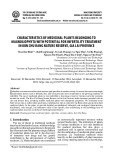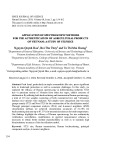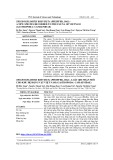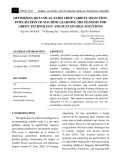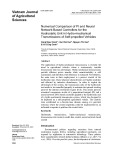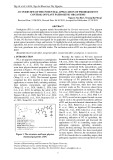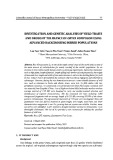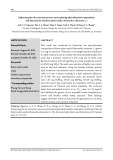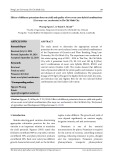
TAÏP CHÍ KHOA HOÏC VAØ COÂNG NGHEÄ ÑAÏI HOÏC COÂNG NGHEÄ ÑOÀNG NAI
52
Số: 03-2024
DEVELOPMENT OF CONCENTRATED SPINACH PRODUCT
WITH VACUUM EVAPORATOR
Huynh Kim Phung1, Ho Thi Ngoc Nhung2, Lai Thi Hien2, Huynh Thi Thuy Loan2,
Pham Hong Bao Han2, Nguyen Minh Thong2, Nguyen Thi Thuy Duyen2*
1Hutech University
2Dong Nai Technology University
*Corresponding author: Nguyen Thi Thuy Duyen, nguyenthithuyduyen@dntu.edu.vn
1. INTRODUCTION
Spinach (Spinacia oleracea L.) is indeed
one of the most nutritious leafy vegetables,
member of the Amaranthaceae family (Roberts
& Moreau, 2016). It is true that spinach
contains various phytochemicals with different
biological activities that are associated with its
anti-obesity, anti-cancer, hypolipidemic, and
hypoglycemic characteristics (Roberts &
Moreau, 2016). It is packed with protein,
carbohydrates, and fat, in addition to a wealth
of minerals and vitamins that offer exceptional
nutritional value.
Spinach is known to be a rich source of
micronutrients such as iron, calcium,
magnesium, copper, vitamins, and antioxidants,
according to some studies (Roughani, A.,
2019). It also contains small amounts of
vitamins E, A, C, K, folate, thiamine (B1),
pyridoxine (B6), riboflavin (B2), and omega 3,
which play an essential role in the maintenance,
repair, and regulation of human tissues.
Furthermore, spinach is a rich source of dietary
fiber (Slavin, and Lloyd, 2012), with just 100
grams of spinach, you can get two-thirds of
your daily requirement of vitamin A, almost all
the folic acid you need in a day, half the dose of
vitamin C, almost a quarter of your daily iron
needs, and over a quarter of your daily
magnesium needs (M.A. Nur, 2023).
It has been found that alternative
technology is required to expedite moisture
removal in vegetable or fruit extracts such as
orange to better preserve their beneficial
attributes. A recent study evaluated the vacuum
concentration (VC) process for rapid
evaporation of moisture from the extracts.
GENERAL INFORMATION
ABSTRACT
Received date: 09/01/2024
The objective of this study was to investigate the production of
spinach concentrate. The research has shown that several factors
affect the concentration process, including the ratio of
vegetables to water in the grinding process, the content of
potatoes mixed into the product, and the time of concentration.
After experimentation, the optimal parameters were found to be
a vegetable-to-water ratio of 150:50, a potato content of 50g, and
an concentration time of 20 minutes. The resulting vegetable
concentrate had a viscosity of 6283 mPa.s, moisture content of
81.04 0.07 and Brix value of 7.0 0.3 with omega-3 content
including α-linolenic acid (ALA), Eicosatrienoic (EPA),
Docosahexaenoic acid (DHA) in the final product is 51.4 ± 0.3
mg/100g.
Revised date: 21/03/2024
Accepted date: 17/04/2024
KEYWORD
Brix;
Spinach;
Vacuum concentration;
Viscosity.

53
TAÏP CHÍ KHOA HOÏC VAØ COÂNG NGHEÄ ÑAÏI HOÏC COÂNG NGHEÄ ÑOÀNG NAI
Số: 03-2024
During VC, moisture is evaporated through
heating of the extract at a lower boiling point of
water under vacuum. The process involves
passing an electric current through the food
from electrodes at both ends of the equipment,
and the electrical energy is converted to heat
depending on the internal energy generated.
Additionally, because VC is performed under a
vacuum, the heat loss of the internal energy
generation is minimized. A study by Vikram,
Ramesh, and Prapulla (2005) found that the
highest vitamin C retention after several
thermal processes. The authors explained that a
shorter lag time of this method resulted in lesser
degradation of vitamin C. Recently, Negri
Rodríguez et al. (2021) reported that there was
a greater color preference and a higher level of
sensory attributes of VC-treated concentrates
than those of concentrates treated using
conventional heating.
From that, we have conducted extensive
research on developing a product that meets the
needs of today’s busy life - vacuum
concentrated spinach. Through our research, we
have optimized the parameters to ensure that we
utilize and retain the most valuable nutritional
components in vegetables through VC method.
We strongly believe that this product is not only
necessary but also has scientific significance,
economic practicality, and profound social
value. We are confident that this product will
make a positive impact on people's lives and
help them achieve a healthy and balanced diet.
2. MATERIALS AND METHODS
2.1. Materials
Spinach and potatoes were purchased from
Trang Dai market, Bien Hoa city, Dong Nai
province.
2.2. Research method
During Experiments 1, 2, and 3, the
concentration process was studied with respect
to several factors, including the ratio of
vegetables to water during the milling process,
the amount of potatoes used in the product, and
the duration of concentration. The moisture,
Brix, and viscosity levels were monitored
throughout the experiments.
In order to investigate the impact of the
ratio of vegetables to water during the grinding
process, we conducted an experiment with five
different ratios: A1 (120:80), A2 (130-70), A3
(140-60), A4 (150-50), A5 (160-40), and A6
(170-30). The experiment was designed with
one factor, five levels, and three replications for
each treatment.
Experiment 2 was conducted to study the
effect of the content of potatoes mixed into the
product. The experiment included three levels
of potatoes: B1 (40g), B2 (50g), and B3 (60g).
The experiment was arranged in a completely
randomized design, with three levels of
potatoes and three replications.
Experiment 3 was carried out to examine
the impact of concentration time on dry matter
content using a vacuum concentrator, with four
different durations tested: 10 minutes, 20
minutes, 30 minutes, 40 minutes, 50 minutes.
The concentration process was conducted at a
temperature of 70°C with 0.4 Bar. The goal of
this experiment was to identify the optimal
parameters for the concentration process.
After the concentration process, the final
product was analyzed to determine the
effectiveness of the vacuum concentration
method in retaining omega-3 content.
Fig 1. Flow Chart
2.2.2. Analytical methods

TAÏP CHÍ KHOA HOÏC VAØ COÂNG NGHEÄ ÑAÏI HOÏC COÂNG NGHEÄ ÑOÀNG NAI
54
Số: 03-2024
Viscosity was measured using a hand-held
viscometer, Ametek Brookfield - American,
model (XD V2TLVTJ00E00). Device
parameters are 0.1 – 200rpm, 15-6,000,000
mPa.s.
Moisture was determined using an infrared
hygrometer of model (AND MF-50). Device
parameters: Min. Recommended Moisture
Range (%MC): 0.01, Repeatability (sd) with 2g
Sample: 0.05 %, Drying Temperature: 40 °C –
230 °C.
Brix Meter 0-90% Brix Meter Handheld
Refractometer Home Measuring Instrument
Brix Meter Brix Meter ATC Temperature.
And the Omega-3 content was determined
following the AOAC 2016 (996.06) method.
Three treatment formulations and one
control were used to perform sensory
evaluation (Color, Smell, Structure). Products
would be evaluated sensory to choose the
highest preferred level products by Score
sensory evaluation method.
2.2.3. Analyzing data
Experimental data analyzed and graphed
on Microsoft Excel 2013. Analysis of variance
(ANOVA) to compare treatments.
The experimental data was analyzed and
graphed using Microsoft Excel 2013. ANOVA
(Analysis of variance) was performed to
compare the different treatments.
3. RESEARCH RESULTS
3.1 Survey results on the ratio of vegetables
and water
Based on Table 1, it can be observed that
there is a positive correlation between the
percentage of vegetables and the viscosity of
the puree product, as higher percentages of
vegetables corresponded to higher viscosity
values in mPas. Additionally, according to
TCVN 5305:2008 (CODEX STAN 57 – 1981,
Rev.2007), the Brix of the puree product should
be between 7% and 24% of the total naturally
dissolved solids content. The results in Table 1
demonstrated that the samples with ratios of
vegetables to water of 150:50, 160:40, and
170:30 had Brix values greater than 7, meeting
the requirement for the puree product.
Moreover, statistical analysis indicated that
these samples were not significantly different
from each other (p > 0.05) in terms of Brix
values.
Furthermore, Table 1 also demonstrated
that there was an increase in viscosity with an
increase in the percentage of vegetables, with
sample 6 having the highest viscosity of 7738
mPa.s compared to sample 1, which had a
viscosity of 4020 mPa.s. This suggests that the
concentration of spinach increased with the
increase in solid content and decrease in
moisture. This phenomenon has been reported
previously for tapioca meal (Abdul-Rasaq A.
Adebowale, 2013), where the viscosity
increased as the solid content increased and the
viscometer speed decreased.
After considering the sensory quality of the
product, as well as the Brix and viscosity
values, sample 4 with a ratio of vegetables to
water of 150:50 was chosen for further
experimental surveys as it had a viscosity
closest to the desired product viscosity.
Table 1. Table of viscosity criteria
Sample
Ratio
Viscosity
(mPa.s)
1
120:80
4020 9f
2
130:70
5500 26e
3
140:60
6142 12d
4
150:50
6300 15c
5
160:40
7400 9b
6
170:30
7738 9a
Table 2. Table of criteria (Brix, Moisture)
Sample
Brix (%)
Moisture (%)
1
6.5 0.1b
93.1 0.987a
2
6.7 0.2 ab
93.04 0.03a
3
6.8 0.2 ab
92.3 0.3ab
4
7.0 0.2a
91.6 0.2b
5
7.0 0.1a
91.52 0.03b
6
7.1 0.2a
91.46 0.02b

55
TAÏP CHÍ KHOA HOÏC VAØ COÂNG NGHEÄ ÑAÏI HOÏC COÂNG NGHEÄ ÑOÀNG NAI
Số: 03-2024
3.2 The result of the combination of potato
content in the product
According to the sensory evaluation results
presented in table 3, it was observed that the
three potato samples with weights of 40g, 50g,
and 60g respectively, had significant
differences (p<0.5%) in terms of viscosity.
Adding 50g of potatoes to the product resulted
in the most preffered structure and flavor, with
a corresponding viscosity of 4285 16 mPa.s
(Fig 2), moisture of 91.2 0.07% (Fig 2), and
Brix of 7.1 0.2% (Fig 1). However, the taste
was found to be similar for all three samples
(40g, 50g, 60g) at a 95% confidence level.
The sensory evaluation panel did not like
the sample made with 40g of vegetable
concentrate because it was too dilute, and the
sample made with 60g of concentrate was too
thick. Additionally, adding more potatoes to the
spinach mixture resulted in a lighter green
color, which was not visually appealing and led
to a low rating. Based on these observations, it
was concluded that sample number 2 with a
potato weight of 50g should be selected as the
standard sample for further experiments.
Table 3. Sensory evaluation of products
Potato
content (g)
Color
Smell
Structure
40
1.6670.3b
2.170.5a
3.00.3b
50
30.5a
30.5a
3.50.5a
60
2.2500.4ab
2.50.5a
2.30.3c
Fig 1: Fig of criteria (Brix) after adding with
potato in the product
Fig 2: Fig of criteria (Moisture, Viscosity) after
adding with potato in the product
3.3. The results on the effect of
concentration-time on dry matter content by
vacuum concentrator
According to the results in Table 4, table 5
it is clear that the taste of the product is highly
appreciated when the concentration time is 20
minutes. The sensory evaluation score at this
time has no significant difference with the score
at 30 minutes incubation time (p<0.5).
Additionally, the product structure was most
favored when the concentration time was 20
minutes. However, there were significant
differences between treatments for product
structure (p<0.5). The sensory evaluation of
color was similar to that of taste for treatments
2 and 3.
There were significant differences between
treatments in Moisture, Brix, viscosity, Omega
-3 results (Table 6, table 7) (p<0.5). Humidity,
nutritional content of omega-3 are inversely
proportional to temperature while Brix and
viscosity are increase with decreasing
temperature.
To achieve high consumer preference, it is
important to retain the maximum nutritional
content in the product, such as omega-3 content
at 51.4 ± 0.3 mg/100g. The content of this free
fatty acids is consistent with the research results
of M Antonia Murcia, 1992. The total lipid
content (0-61%) is determined in two
processing stages with fatty acids such as
palmitic, hexadecadienoic, hexadecenoic,

TAÏP CHÍ KHOA HOÏC VAØ COÂNG NGHEÄ ÑAÏI HOÏC COÂNG NGHEÄ ÑOÀNG NAI
56
Số: 03-2024
stearic and hexadecatrienoic, oleic, linoleic,
and linolenic.
Therefore, treatment 2 will be selected to
proceed the production of spinach concentrate.
Table 4. Sensory evaluation of products
Experimen
t
Time
(minutes
)
Smell
Color
1
10
1.917 0.4
ab
2.760.17
a
2
20
2.9170.5a
3.370.35
a
3
30
2.2500.35a
b
2.670.29
a
4
40
1.2500.2bc
1.550.23
b
5
50
1.1670.7c
1.40.4b
Table 5. The result after the concentration
process (Structure)
Experiment
Time
(minutes)
Structure
1
10
2.5230.2 b
2
20
3.2000.4a
3
30
2.5910.7b
4
40
2.4320.6b
5
50
1.4750.3c
Table 6. The result after the concentration
process (Moisture, Brix)
Experiment
Time
(minutes)
Moisture
(%)
Brix (%)
1
10
92.6
0.12a
6.7 0.2c
2
20
81.04
0.07b
7.0 0.3c
3
30
79.2
0.04bc
7.0 0.1c
4
40
77.9
0.17c
8.1 0.3b
5
50
76.08
0.11d
9.5 0.2a
Table 7. The result after the concentration
process (Viscosity, Omega – 3)
Experiment
Time
(minutes)
Viscosity
(mPa.s)
Omega – 3
(mg/100g)
1
10
5110
21e
52.9 0.1a
2
20
6283
18d
51.4 0.3
b
3
30
6824
9c
48.6 0.2c
4
40
7135
13b
45.2 0.2d
5
50
7619
25a
40.4 0.3e
Omega – 3 include α-linolenic acid (ALA),
Eicosatrienoic (EPA), Docosahexaenoic acid (DHA)
3. CONCLUSION
It seems like the experiments have yielded
some optimal parameters for the spinach
concentration process using a vacuum
concentrator. According to the results, the
vegetable-to-water ratio of 150:50, potato
content of 50g, and an evaporation time of 20
minutes have resulted in a concentrated
vegetable product with a viscosity of 6283 18
mPa.s, humidity of 81.04 0.07%, and Brix of
7.0 0.3%. Moreover, the final product was
tested for omega-3 content, including α-
linolenic acid (ALA), Eicosatrienoic (EPA),
Docosahexaenoic acid (DHA), and the results
showed a content of 51.4 mg/100g.
REFERENCES
Abdul-Rasaq, A. A. & Lateef, O. S. (2013).
Effects of solid content and temperature on
viscosity of tapioca meal. J Food Sci
Technol. 50(3): 573–578.
Man, L. V. V. (2011). Công nghệ chế biến thực
phẩm, Nhà xuất bản Đại học Quốc Gia
Thành phố Hồ Chí Minh.
Murcia, M.A, Vera, A. (1992). Effect of
processing methods on spinach: Proximate
composition in fatty acids and soluble
protein, Journal of food and agriculture.
59(4):473-476.

